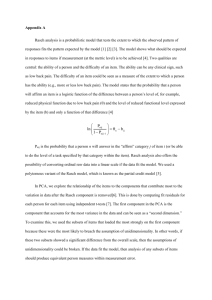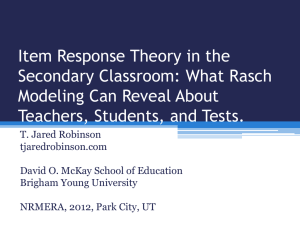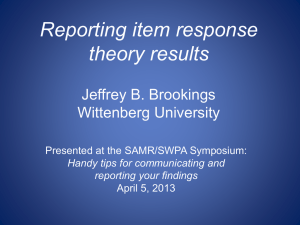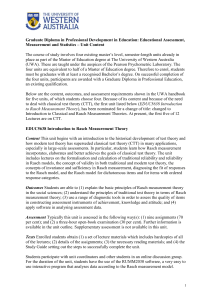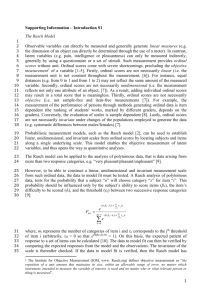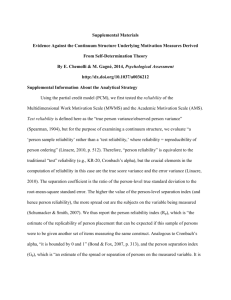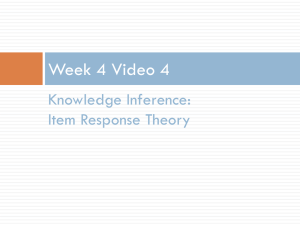this PDF file
advertisement
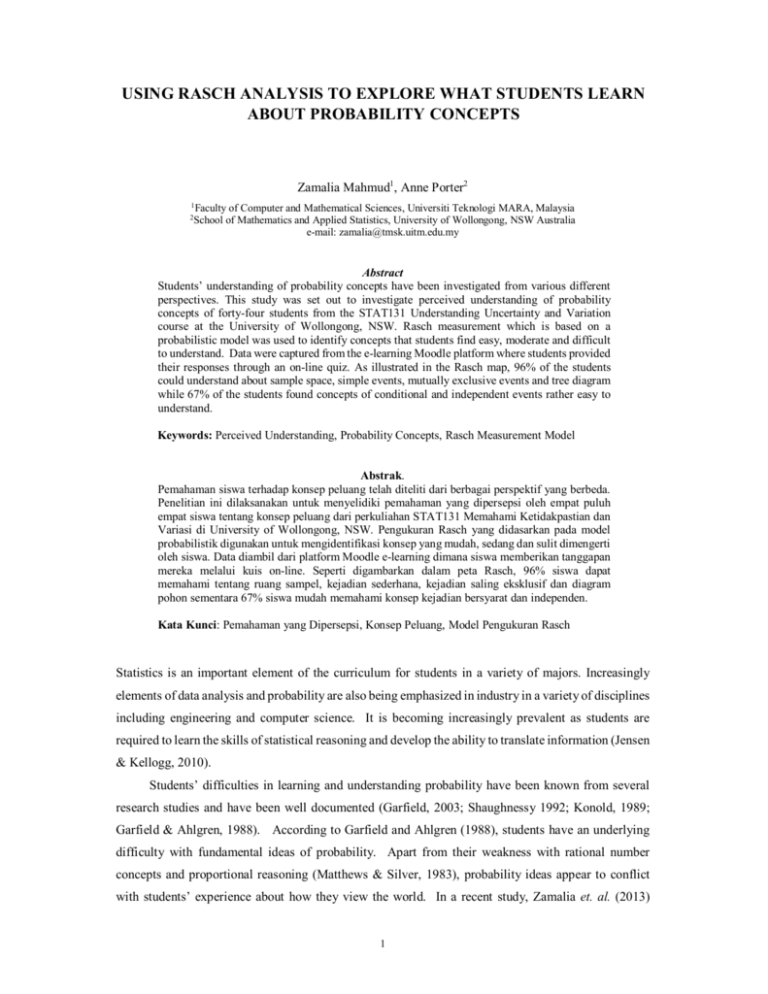
USING RASCH ANALYSIS TO EXPLORE WHAT STUDENTS LEARN
ABOUT PROBABILITY CONCEPTS
Zamalia Mahmud1, Anne Porter2
1
2
Faculty of Computer and Mathematical Sciences, Universiti Teknologi MARA, Malaysia
School of Mathematics and Applied Statistics, University of Wollongong, NSW Australia
e-mail: zamalia@tmsk.uitm.edu.my
Abstract
Students’ understanding of probability concepts have been investigated from various different
perspectives. This study was set out to investigate perceived understanding of probability
concepts of forty-four students from the STAT131 Understanding Uncertainty and Variation
course at the University of Wollongong, NSW. Rasch measurement which is based on a
probabilistic model was used to identify concepts that students find easy, moderate and difficult
to understand. Data were captured from the e-learning Moodle platform where students provided
their responses through an on-line quiz. As illustrated in the Rasch map, 96% of the students
could understand about sample space, simple events, mutually exclusive events and tree diagram
while 67% of the students found concepts of conditional and independent events rather easy to
understand.
Keywords: Perceived Understanding, Probability Concepts, Rasch Measurement Model
Abstrak.
Pemahaman siswa terhadap konsep peluang telah diteliti dari berbagai perspektif yang berbeda.
Penelitian ini dilaksanakan untuk menyelidiki pemahaman yang dipersepsi oleh empat puluh
empat siswa tentang konsep peluang dari perkuliahan STAT131 Memahami Ketidakpastian dan
Variasi di University of Wollongong, NSW. Pengukuran Rasch yang didasarkan pada model
probabilistik digunakan untuk mengidentifikasi konsep yang mudah, sedang dan sulit dimengerti
oleh siswa. Data diambil dari platform Moodle e-learning dimana siswa memberikan tanggapan
mereka melalui kuis on-line. Seperti digambarkan dalam peta Rasch, 96% siswa dapat
memahami tentang ruang sampel, kejadian sederhana, kejadian saling eksklusif dan diagram
pohon sementara 67% siswa mudah memahami konsep kejadian bersyarat dan independen.
Kata Kunci: Pemahaman yang Dipersepsi, Konsep Peluang, Model Pengukuran Rasch
Statistics is an important element of the curriculum for students in a variety of majors. Increasingly
elements of data analysis and probability are also being emphasized in industry in a variety of disciplines
including engineering and computer science. It is becoming increasingly prevalent as students are
required to learn the skills of statistical reasoning and develop the ability to translate information (Jensen
& Kellogg, 2010).
Students’ difficulties in learning and understanding probability have been known from several
research studies and have been well documented (Garfield, 2003; Shaughnessy 1992; Konold, 1989;
Garfield & Ahlgren, 1988). According to Garfield and Ahlgren (1988), students have an underlying
difficulty with fundamental ideas of probability. Apart from their weakness with rational number
concepts and proportional reasoning (Matthews & Silver, 1983), probability ideas appear to conflict
with students’ experience about how they view the world. In a recent study, Zamalia et. al. (2013)
1
2
IndoMS-JME, Volume 6, No. 1, January 2015, pp. 1-10
discovered that about 38% of the students perceived little understanding on certain basic probability
concepts such as conditional probability and independent events. Thus the main purpose of this study is
to investigate the level of students’ perceived understanding of probability concepts and identify which
concepts were found most difficult by the students to understand.
Over the years, research into how students learn has evolved in many different directions. A large
number of studies has been carried out in areas such as cognitive aspects of learning (Kolb, 1984; SadlerSmith, 1996; Garfield, 1995; Garfield and Chance, 2000). Students enter learning processes with
different background characteristics such as a preference for deep learning versus surface learning, and
specific subject attitudes, and different perceptions of the learning context. Most of these contexts allow
all students to achieve satisfactory learning outcomes, with different learning paths (Tempelaar, 2006).
Statistical concepts are the basis of learning statistics and therefore should be given extra attention
by every educational institution. Much research in the different types of statistical reasoning such as
reasoning about variation, distribution, and sampling distributions, has created important insights into
the developmental process of a student’s learning of statistical reasoning skills (Tempelaar, 2006).
Studies have also shown that students have difficulty with reasoning about distributions and graphical
representations of distributions (Garfield and Ben-Zvi, 2004), understanding concepts related to
statistical variation such as measures of variability (delMas, Garfield & Chance, 1999) and sampling
distributions (Saldanha & Thomson, 2001). Contemporary research in statistics education distinguishes
an array of different but related cognitive processes in learning statistics: statistical literacy, statistical
reasoning, and statistical thinking. Literacy, reasoning, and thinking are to some extent achieved even
before formal schooling in statistics takes place. Those naïve conceptions learned outside school can be
correct or incorrect in nature (Tempelaar, Schim & Gijselaers, 2007).
Garfield (2003) made the attempt to assess student’s reasoning through the Statistical Reasoning
Assessment (SRA) but the items in the SRA are focused more on the probability topics instead of basic
statistical concepts. The SCI (Statistics Concept Inventory) too was developed to assess statistical
understanding but it was specifically designed for the engineering students (Reed-Rhoads, Murphy, &
Terry, 2006). After three years of research on their Assessment Resource Tools for Improving Statistical
Thinking (ARTIST) project, funded by the NSF (National Science Foundation), delMas, Garfield, Ooms
and Chance (2007) produced an online test, Comprehensive Assessment of Outcomes in Statistics
(CAOS). The objective of CAOS is to measure students’ understanding on the topics contained in most
introductory statistics courses.
METHOD
Study Design
A survey was administered on 44 undergraduate students representing the mathematics and
computer sciences. They enrolled in the STAT131 Understanding Variation and Uncertainty as part of
the requirement for their various programmes of study. The students responding had volunteered to
Mahmud & Porter, Using Rasch Analysis to …
3
participate by providing brief information about their profile. They were given a set of questionnaire to
answer. The questionnaire asked how they perceived their understanding in probability concepts. The
items constructed are related to the probability concepts where students would need to read through and
understand the term, definition or examples. A sample of the items is shown in Table 1.
The students had responded to the items based on the perceived level of understanding scales of
between (1) and (5) as follows:
1. I have NO UNDERSTANDING of the term, definition or example.
2. I have LITTLE UNDERSTANDING of the term, definition or example.
3. I have SOME UNDERSTANDING of the term, definition or example.
4. I have GOOD UNDERSTANDING of the term, definition or example.
5. I have FULL AND COMPLETE UNDERSTANDING of the term, definition and example.
Table 1. Items Representing Perceived Understanding of Probability Concepts
B.
B1_i
Relationships Among Events
Complementary Event
Let E = Event E occurs
(1)
(2) (3) (4) (5)
Let E’ = Event E does not occur.
then P(E’) = 1- P(E)
B1_ii Example:
A die is toss once.
The sample space S={1,2,3,4,5,6}, so n(S) = 6
Let A = Event obtaining a 3 on the uppermost face
Let B = Event not obtaining a 3 on the uppermost face
(1)
(2)
(3) (4) (5)
(1)
(2)
(3) (4) (5)
P(A) = 1/6
P(B) =1-1/6 = 5/6
B2_i General Addition Rule
Given two events, A and B, the probability of their union,
A B is equal to P(A B) = P(A) + P(B) – P(A B)
In order for the calibration to hold between person and test items, students’ responses to the
questions were captured and raw scores obtained which are then converted to interval logit values using
the Polytomous Rasch measurement model. Students’ responses to the questionnaires were captured in
Moodle site and later exported as an Excel file. Data were analyzed using Winsteps 3.74.0 software to
produce the relevant Rasch output (Linacre, 2007).
4
IndoMS-JME, Volume 6, No. 1, January 2015, pp. 1-10
Polytomous Rasch Model
Also known as a probabilistic model, Rasch measurement takes into account two parameters –
test item difficulty and person ability.
The polytomous (rating scale) Rasch model establishes the relative difficulty of each item from
the lowest to the highest levels the instrument is able to record. It is more complex than the dichotomous
Rasch model as it is possible to endorse one of the many response categories on a scale. The items
indicate a rather more complicated representation than the one for dichotomous data. For dichotomous
data, each item is represented as having a single item estimate, with an associated error estimate. For
rating-scale data, not only does each item have a difficulty estimate, but the scale also has a series of
thresholds (i.e., the level at which the likelihood of failure at a given response category [below the
threshold] turns to the likelihood of success at that category [above the threshold]).
Response categories in Likert instruments may include ordered ratings, such as “Strongly
Disagree/ Disagree/ Agree/ Strongly Agree”, to represent a respondent’s increasing inclination towards
the concept questioned. The response rating scale, when it works, yields ordinal data which need to be
transformed to an interval scale to be useful. This is achieved by the Rasch rating scale model (Andrich,
1978).
The polytomous “Rasch Rating Scale” model is a mathematical probability model, which
incorporates an algorithm that expresses the probabilistic expectations of item and person responses,
which estimates the probability that a person will choose a particular response category or an item as:
ln Pnij / Pni ( j 1 ) B n D i F j
where,
ln
= a natural logarithm
Pnij
= the probability of respondent n scoring in category j for item i
Pni(j-1)
= the probability of scoring in category (j-1)
Bn
= the person measure/ability of respondent n
Di
= the difficulty of item i
Fj
= the difficulty of category step j
(the threshold at which there is a 50-50 chance of scoring in category j and category j – 1)
Mahmud & Porter, Using Rasch Analysis to …
5
Table 2. Thresholds and Category Fit
Information in Table 2 helps the investigation of the rating scale quality as to whether the
categories fit the model sufficiently well and whether the thresholds indicate a hierarchical pattern to
the rating scale. Basic examination of rating scale used in the Table 2 indicates that each category has
provided enough observations for an estimation of stable threshold values. The recommended minimal
number of responses per category is 10 (Linacre, 1999a). Based on step calibrations of Andrich
threshold, all categories are ordered and increases monotonically. For example, Category 1 was
recorded as -2.93 which can be interpreted as the average ability estimate, or logit score, for persons
who chose Category 1 on any item in the questionnaire. Similarly for Category 2 until Category 5. To
further support this, observation based on outfit mean squares for each category shows the fit of each
rating scale category to the unidimensional Rasch model meet the criterion of mean square statistics less
than 2.0 (Linacre, 1999a).
Figure 1. Probability curves for a well-functioning five category rating scale
6
IndoMS-JME, Volume 6, No. 1, January 2015, pp. 1-10
The Rasch analysis places persons (Bn) and items (Di ) on the same measurement scale where the
unit of measurement is the logit (logarithm of odds unit). The person’s likely score is defined by the
interaction between the person’s measure, the item’s difficulty, and the score’s category threshold.
These parameters are assumed to be interdependent. However, separation between the two
parameters is also assumed. For example, the items (questions) within a test are hierarchically ordered
in terms of their difficulty and concurrently, persons are hierarchically ordered in terms of their ability.
The separation is achieved by using a probabilistic approach in which a person’s raw score in a test is
converted into a success-to-failure ratio and then into a logarithmic odds that the person will correctly
answer the items (Bond & Fox, 2007). This is represented in a logit scale. When this is estimated for all
persons, the logits can be plotted on one scale.
RESULTS AND DISCUSSION
Perceived Understanding in Probability Concepts
Table 3 presents the summary statistics for perceived understanding in probability concepts based
on the analysis of data using Rasch measurement tools. The statistics show the mean infit and outfit for
person and item mean squares are close to 1.0 which indicate that in general the data had shown
acceptable fit to the model. The mean standardized infit and outfit for person is between -0.3 and -0.2.
The standardized outfit is within acceptable range of rasch measurement ( 1.0). The mean standardized
infit and outfit for items is located at 0. This indicates the items measure are slightly overfit and that the
data fit the model somewhat better than expected. (Bond & Fox, 2007).
Table 3. Summary Measures of Perceived Understanding in Probability Concepts
Table 3 shows the standard deviation of the standardized infit as an index of overall misfit for
persons and items. Using 2.0 as a cut-off criterion, standardized infit/outfit standard deviation for
Mahmud & Porter, Using Rasch Analysis to …
7
persons is between 2.0 and 2.2 and standardized infit/outfit standard deviation for items is between 1.3
and 1.5. All show an overall acceptable fit.
Separation is the index of spread of the person positions or item positions. Separation of 1.0 or
below indicates the items may not have sufficient breadth in position. For persons, separation is 4.05
for the data at hand (real) indicating approximately four levels of person ability. The item on the other
hand has a separation index of 5.23 which indicates item difficulty can be separated into 5 levels.
Person and item separation and reliability of separation assess instrument spread across the trait
continuum. Separation also determines reliability. Higher separation in concert with variance in person
or item position yields higher reliability. The person separation reliability estimate for this data is 0.94
which indicate a wide range of students’ ability. The item separation reliability estimate is 0.96 which
indicates items are replicable for measuring similar traits.
The mean of the item logit position is always arbitrarily set at 0.0, similar to standardized z-score.
The person mean is 0.94 suggesting that a small group of students had perceived their understanding of
probability concepts quite well. From the perspective of Rasch measurement, this indicates some items
were easily endorsed or easy to agree with.
Person-Item Distribution Map for Perceived Understanding
Figure 2. Person-Item Distribution Map of Perceived Understanding of Probability Concepts
8
IndoMS-JME, Volume 6, No. 1, January 2015, pp. 1-10
Figure 2 shows the person-item distribution map of perceived understanding of probability
concepts. The map display the distribution of students (on the left side of the map) according to their
ability from most able to least able in endorsing items as agree or correct. The map also displays the
items according to the difficulty levels.
It is expected that many students will have little or no understanding about Bayes’ theorem and
conditional probability concepts. At the time when this instrument was administered, conditional
probability was exposed using few practical examples while the illustration of the Bayes’ Theorem
formula was not emphasized. Hence, there is a slight mismatch between how the concept was taught
and the development of the items. This explains why majority of the students could not endorse items
B7i, B7ii, B7iii and B7iv (logit values between 2.0 and 2.5), items which are related to the Bayes’
Theorem concept. On the other hand, about 97% of the students found concepts A1ii, B8iii and B9iii
(at logit value of -1.0) which are directed to simple definitions of event, probability and tree diagrams
are the easiest to endorse. Only about 33% of the students found concepts of conditional and independent
events as difficult to understand. Generally students have perceived the items as quite easy to understand
as the item mean logit is lower than the person mean logit.
In the investigation of data fitting the model, the distribution of empirical data are plotted across
the expected values for the perceived understanding Likert scale items (Group L) as shown in Figure 3.
The characteristic curve for all empirical values in Group L falls along the expected ogive curve and
within the upper and lower bound of the 95% confidence interval. This indicates a good item person
targeting for the perceived understanding of probability items. This also signals the data fit the model
better than expected.
Figure 3. Empirical-Expected Item Characteristic Curves For Perceived Understanding Items
Mahmud & Porter, Using Rasch Analysis to …
9
CONCLUSION AND SUGGESTION
This study has shown that students’ level of perceived understanding of probability concepts can
be identified using the Rasch polytomous measurement tools. Generally a large number of students
(96%) perceived a good understanding about sample space, simple events, complementary events, and
mutually exclusive events. About 96% of the students could understand about sample space, simple
events, mutually exclusive events and tree diagram while 67% of the students found concepts of
conditional and independent events rather easy to understand. A brief interview with several students
confirmed that they have difficulties learning these concepts due to lack of exposure to these concepts
at schools. However, current teaching in the STAT131 class has helped them to deal with prior
misunderstandings of probability concepts. Students who initially have little understanding of the
probability concepts wish to demonstrate a greater understanding of the concepts after two weeks of
exposure to the topics.
REFERENCES
Andrich, D. (1978). A Rating Formulation for Ordered Response Categories. Psychometrics, 43, 561-73.
Bond, T.G. & Fox, C.M. (2007). Applying The Rasch Model: Fundamental Measurement In The Human
Sciences. New Jersey: Lawrence Erlbaum Associates.
delMas, R., Garfield, J., & Chance, B. (1999). A Model of Classroom Research In Action: Developing
Simulation Activities To Improve Students’ Statistical Reasoning. Journal of Statistics
Education, 7 (3).
delMas, R., Garfield, J., Ooms, A., & Chance, B. (2007). Assessing Students’ Conceptual Understanding
After A First Course In Statistics. Statistics Education Research Journal, 6 (2), 28-58.
Garfield, J. & Ahlgren. (1988). Assessing Students’ Conceptual Understanding After A First Course In
Statistics; Difficulties in Learning Basic Concepts in Probability and Statistics: An Implication
for Research. Journal for Research in Mathematics Education, 19 (1), 44-63.
Garfield, J. & Ben-Zvi, D. (2004). Developing Students Statistical Reasoning: Connecting Research
And Teaching Practice. Springer.
Garfield, J. (1995). How Students Learn Statistics. International Statistical Review, 63 (1), 25-34.
Garfield, J. (2003). The Challenge of Developing Statistical Reasoning. Journal of Statistics Education, 10, 3.
Garfield, J. & Chance, B. (2000). Assessment in Statistics Education: Issues and Challenges.
Mathematics Thinking and Learning, 2, 99-125.
Jensen, D. & Kellogg, S. (2010). Improving Conceptual Understanding in Probability and Statistics.
American Society for Engineering Education, 2-15.
Kolb, D.A. (1984). Experiential Learning: Experience As The Source of Learning And Development.
Englewood Cliffs, NJ: Prentice Hall
Konold, C. (1989). Informal Conceptions of Probability. Cognition and Instruction, 6, 59-98.
Linacre, J.M. (2002). Understanding Rasch Measurement: Optimal Rating Scale Category
Effectiveness. Journal of Applied Measurement, 3, 85-106.
10
IndoMS-JME, Volume 6, No. 1, January 2015, pp. 1-10
Linacre, J.M. (2007). A User’s Guide to WINSTEPS. Chicago: Winsteps.com.
Reed-Rhoads, T., Murphy, T. J., & Terry, R. (2006). The Statistics Concept Inventory (SCI). Retrieved
from http://coecs.ou.edu/sci/
Sadler-Smith, E. (1996). Approaches to Studying: Age, Gender, and Academic Performance.
Educational Studies, 22 (3), 367-379.
Saldanha, L.A. & Thompson, F.W. (2001). Students’ Reasoning about Sampling Distributions and
Statistical Inference. In R. Speiser & C. Maher (Eds.), Proceedings of The Twenty-Third Annual
Meeting of the North American Chapter of the International Group for the Psychology of
Mathematics Education. Snowbird, Utah. Columbus, Ohio: ERIC Clearinghouse, 449-454.
Shaughnessy, J.M. (1992). Research in probability and statistics: Reflections and directions. In
Handbook of Research on Mathematics Teaching and Learning. D.A. Grouws (Ed.). pp. 465-494.
New York: Macmillan
Tempelaar, D. (2006). A Structural Equation Model Analyzing The Relationship Students’ Statistical
Reasoning Abilities, Their Attitudes Toward Statistics And Learning Approaches. Proceedings
of The 7th International Conference on the Teaching of Statistics. ICOTS-7.
Tempelaar, D., Schim van der Loeff, S., & Gijselaers, W.H. (2007). A Structural Equation Model
Analyzing the Relationship of Students’ Attitudes Toward Statistics, Prior Reasoning Abilities,
and Course Performance. Statistics Education Research Journal, 6 (2), 78-102.
Zamalia, M., Porter, A., Nor Izzati, O., Masniyati, S., Az’lina, A. H., & Shamsiah, S. (2013).
Understanding Probability Concepts and Learning Styles Among Students of the Malay Culture:
A Rasch Analysis. Wulfenia Journal, 20 (1), 98-115.
